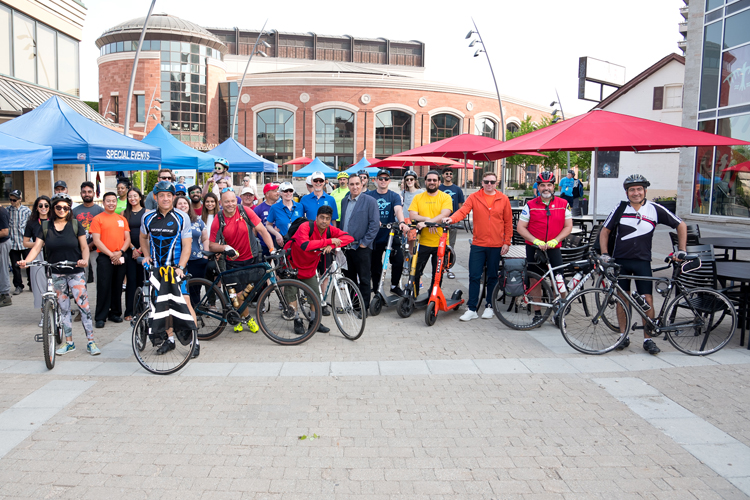City of Brampton hosted a celebration of Bike to Work Day on June 1 in Garden Square. Welcomed were BikeBrampton, Different Spokes DT bike hub, Brampton Cycling Club, Algoma U, Brampton Transit, Ride Don’t Hide and 3 e-scooter companies: Bird, Scooty, and Neuron. McDonalds sponsored complementary breakfast. This was a great kick-off to Bike Month!

Mayor Patrick Brown and Brampton Council proclaimed June is Bike Month in Council the day before.


As riders entered Garden Square, old and new friends met.









“Time for an honest discussion about your future. You may have had one of these conversations with your parents when reaching adolescence. Or with your employer when you didn’t know if you were being shown the door or promoted. When someone says to you that they need to have an honest conversation with you about your future, it’s always unsettling.
But it is time for an honest conversation about the future of transportation in Brampton, and the GTA. If we are to continue to live and move comfortably in our community there must be safe, convenient, and healthy alternatives to the personal automobile, including public transit, walking, cycling, and other micro-mobility options.
It’s not about a war on the car. 87% of Ontarians who ride bikes regularly are also drivers.¹ I’m one of them. Cars are great. We love the convenience. They are at our beck and calling 24/7. They are built to surround us with comfort and luxury. They can swiftly and easily transport us along with our heavy loads from place to place in style.
But cars have a huge downside. They are both literally and figuratively killing us: environmentally, socially, and economically.
Huge amounts of public space dedicated to cars for roads and parking. More than 25% of Toronto’s public space is devoted to roads while only 13% is parks and greenspace.² Canada is estimated to have 97 million parking spaces or about 4 parking spaces for every Canadian vehicle.³
More than 1,700 people die on Canada’s roads every year. 108,000 are injured, with more than 8,100 of them being serious enough to be taken to hospital.4
Interestingly cyclists were the lowest percentage of fatalities at 2.5% of any road user class including drivers, passengers, pedestrians, and motorcyclists. 4

Car driving contributes to our sedentary lifestyle which leads to disease causing suffering and huge economic expense. The cost of treating Type II diabetes is over $689M annually in Peel. 5
Cars contribute to social isolation. We do not connect with each other when we are surrounded by tons of sheet metal.
Car use represents a huge burden on the tax-paying public. Direct driver related fees including fuel taxes, road tolls, license fees, pay for approximately 50% of road construction and maintenance costs. The other half is paid for out of general tax revenues including income and property taxes. 6
Local road, maintenance costs are about $0.036/km for each car year. Drivers directly pay for less than 1/6 of that cost. The rest is borne by general taxpayers. 6
Expenditures on bicycle infrastructure represent about 1% of the total transportation costs. Bicycles do not contribute significantly to road wear and tear.
Therefore, cyclists’ tax dollars subsidize car driver use of the road.
In Copenhagen, 50 years ago car use was similar to North American cities at the time. Today, more than 80% of the City’s residents regularly ride a bicycle for transportation. It’s been estimated that, each mile travelled in the city by bike, saves the city $0.42 while each mile travelled by car costs the city, $0.20.
The answer is to use cars less and use bikes or other micro-mobility devices more. Use cars for their intended purposes, longer trips, carrying heavier loads. Cycling one-day a week is a good place to start.
To those who rode here this morning on your way to work, thanks, you’re helping offload a burden from the shoulders of society. To those employers who support and encourage their employees to ride to work, give yourself a pat on the back, you are contributing to worker productivity and to shareholder value.
Please help spread the word about the benefits of biking to work or school. Every employee who bikes to work saves all of us tax dollars and helps free up public space for other uses. Thank you for your contributions to a better community and a better world!” – David Laing










References:
- https://www.sharetheroad.ca/news-media-p157824
- https://www.thestar.com/opinion/letters_to_the_editors/2017/04/30/toronto-needs-less-public-space-dedicated-to-cars.html
- https://www.cesarnet.ca/blog/what-if-our-cities-only-needed-fraction-their-parking-spaces
- https://tc.canada.ca/en/road-transportation/statistics-data/canadian-motor-vehicle-traffic-collision-statistics-2021
- https://www.mississauga.ca/wp-content/uploads/2021/11/09160608/type-2-diabetes-fact-sheet.pdf
- https://www.goodreads.com/book/show/17802352-bikenomics
Bike Month TVO interview
“Are Bike Lanes Making Traffic Worse” – The Agenda with Steve Paikin’s interview video link
This excellent interview is well worth the watch!
“Traffic and congestion has come up a lot in Toronto’s mayoral byelection. Some candidates are pointing the blame at bike lanes, arguing that they’re the cause of traffic getting worse in this city. For insights on whether Toronto has implemented bike lanes in the best way possible, we welcome: Eleanor McMahon, former cabinet minister, and president and CEO of the Trans Canada Trail; Trevor Townsend, founder of Keep Toronto Moving; and Alison Stewart, director of ddvocacy and public policy for Cycle Toronto.”


You must be logged in to post a comment.